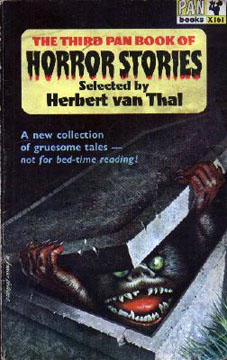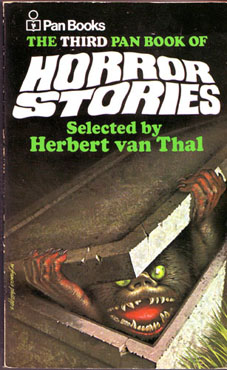 Xeni Jardin and Boing Boing readers reminisce today about the childhood traumas inspired by Sesame Street characters. Wimps, say I, although in fairness I was too old to be frightened of Muppetry by the time that stuff appeared on British TV screens.
Xeni Jardin and Boing Boing readers reminisce today about the childhood traumas inspired by Sesame Street characters. Wimps, say I, although in fairness I was too old to be frightened of Muppetry by the time that stuff appeared on British TV screens.
Scariest thing in the Coulthart household, easily out-classing anything on children’s television (Doctor Who monsters included), was the cover of the third Pan Book of Horror Stories. My parents had a small collection of paperbacks from the early Sixties which included some horror and occult fiction. My sister and I found this book one day while rooting in an old suitcase and were both mortified by it. I seem to remember there being dares to go and look at it again and also have vague recollections of at least one nightmare occurring as a result. A shame there isn’t a larger scan available since I’m curious to know who the artist was.
 A few years later I was reading the Pan series myself although I never went back to this particular one. Herbert van Thal’s selections got off to a good start, reprinting old horror classics with newer fiction, but soon degenerated into detailed and repetitive tales of dismemberment and blood-letting, the kind of stuff that makes you think “cool” when you’re a teenage boy but which is otherwise worthless. Most of the writers in the later books are unheard of elsewhere which makes me suspect they were probably hacks earning a quick couple of quid writing under pseudonyms. The strangest thing about volume three now is looking at the contents list and seeing that we had stories by William Hope Hodgson and Algernon Blackwood in the house all that time and I never knew it.
A few years later I was reading the Pan series myself although I never went back to this particular one. Herbert van Thal’s selections got off to a good start, reprinting old horror classics with newer fiction, but soon degenerated into detailed and repetitive tales of dismemberment and blood-letting, the kind of stuff that makes you think “cool” when you’re a teenage boy but which is otherwise worthless. Most of the writers in the later books are unheard of elsewhere which makes me suspect they were probably hacks earning a quick couple of quid writing under pseudonyms. The strangest thing about volume three now is looking at the contents list and seeing that we had stories by William Hope Hodgson and Algernon Blackwood in the house all that time and I never knew it.
Update: The cover artist was W Francis Phillips.
Elsewhere on { feuilleton }
• The book covers archive
Previously on { feuilleton }
• Druillet meets Hodgson
• A playlist for Halloween
• Ghost Box
• Le horreur cosmique

Gentleman-about-Bristol and pulp scholar Justin Marriott edits Pulpmania and Paperback Dungeon, which touch on these areas:
http://www.pulpmania.co.uk
http://www.myspace.com/pulpmania
although both sites do little to convey the excellent writing within (the Michel Parry interview especially).
Incidentally: childhood terrors? I could begin with the first viewing of The Legend of Boggy Creek on TV, and work onwards from there…!
I’d forgotten about those books, but the early ones were fantastic – my first introduction to Lord Dunsany’s work was in that volume, when I was about ten. It’s odd looking through the listings for the early ones just how widely they were casting the net for stories – seeing “A Rose For Emily”, “The Elephant Man” and John Lennon’s “No Flies On Frank” in such close proximity reminds me just what a wide range of genres ‘horror’ can contain…
Yep, excellent primers. is there an equivalent around now? A paperback series that mixes ‘classics’ and left-field experiments with new fiction? And, of course, gruesome covers…
I can’t think of anything now that approaches these kind of books. And these weren’t the only ones, there was a similar series from Fontana, collections from Michael Parry and Peter Haining et al. Things are a lot more codified and homogenised in all the genres today, conservatism is abroad in the places that were often a haven for subversion and experiment.
Yep, scary enough, but I’ll see that and raise you with this:
http://weirdcovers.ghostbox.co.uk/images/ab_talesmm.jpg
My sister had this book and the cover image of THAT FACE absolutely terrified me. I had recurring nightmares of it looming up at me out of the darkness and even now I find it unsettling to look at. When reading Clive Barker’s The Damnation Game for the first time in 1986, I had violent flashbacks to this image as I read the incredible passage where Mamoulian casts bone dice into the void “while somewhere close by a thing with fire for a head wept and wept until it seemed they would drown in tears.” Barker soon lost it, Blackwood never did and whoever did that cover painting was welcome to his nightmares. We’ll never the like again.
Oh, I’ve got that book! My dust jacket is a bit more worn than that one. Face reminds me a bit of the demon face in The Exorcist. Oddly enough I was thinking of reading some Blackwood again (and Robert Aickman) after listening to a reading of The Willows on BBC 7.
Barker claims to have given up horror in order to have a wider readership. I’m sure he’s sincere about that but when does horror preclude a wider readership? Ask Thomas Harris. The challenge should be to bring the reader along with you but then that’s easy for me to say because I’m not poring over a column of sales figures and the NYT bestsellers list.
What’s depressing about things today–and this applies to comments above–is the way that all the genres have become rigid and codified, like a row of American chain stores. HG Wells wrote short stories that can be classed as horror, science fiction, fantasy (even crime) yet he never thought of himself as a writer of a specific genre; he was a writer first, with the freedom to deal with any subject. HP Lovecraft was the same. Now you have people going on writing courses learning specifically how to write (say) science fiction or fantasy. Hence the recent angst when Cormac McCarthy writes a book that could be classed as sf. Like I said; depressing.
There have been a number of books released over the past year or two inspired by the Pan anthologies.
BHF Book of Horror
Humdrumming Book of Horror
Black Book of Horror